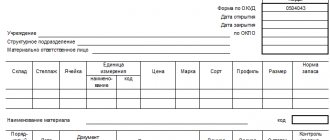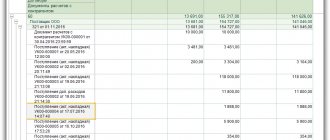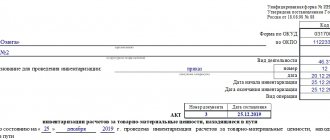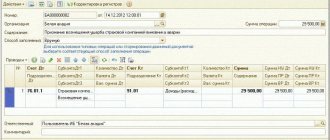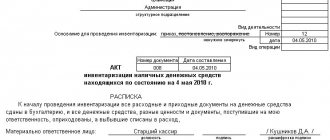The buyer has encountered an inventory of goods at least once. For example, when a department or the entire store is closed during working hours, and the “Accounting” sign hangs. Its goal is to find discrepancies in the actual availability of goods with the data that is in the organization’s accounting system. In order not to stop sales, many stores arrange for inventory and registration of its results on the weekend or even at night. Let's figure out how to carry out recounting.
Inventory will be faster with MyWarehouse - our application can be installed on data collection terminals. Place it on the TSD and scan the goods, pointing the device at the barcodes. There is no need to create an inventory list and a document for discrepancies with the estimated quantity: they will be generated automatically in MyWarehouse. And in our service you can download all the documents that may be useful to you during re-registration: forms and samples of an inventory order, a commodity inventory, a matching sheet and others. All this is completely free. Register and try MyWarehouse right now!
Try MySklad
So where to start? You must be prepared for the fact that you will have to spend additional resources - time and money. This includes: distraction of store employees from their main duties and additional payments to staff for overtime work, lost profits from stopping trade during the inventory period. If the company consists of one person and this person is you, during re-accounting you will have to perform several functions simultaneously: director, financially responsible person and accountant. Therefore, it is important for every entrepreneur to know how to properly conduct an inventory and document its results.
Why do you need an inventory report?
The state obliges enterprises to regularly conduct an inventory of assets and liabilities - this is enshrined in Art. 11 Federal Law No. 402 “On Accounting”. However, the law does not provide for penalties for non-compliance. Therefore, some individual entrepreneurs and organizations do not pay due attention to inventory. But in vain! The event allows you to find out how many goods you have, what condition they are in, and whether there are any losses.
An inventory report is needed to control inventory, cash, intangible assets, as well as debts to counterparties or creditors. With the help of a check, you can find out whether the actual presence of valuables corresponds to the quantity recorded in the accounting documents.
Features of securities inventory
When checking securities, you need to make sure that:
- primary documents are properly prepared;
- the value of the investment is true;
- the actual number of papers coincides with what was recorded in accounting;
- the profitability of this type of investment is reflected on time and correctly in accounting records.
When securities are located on the territory of the company, their inventory must be carried out together with an inventory of cash in the cash desk. If the papers are transferred for storage to a special storage organization, then the verification consists of comparing the balances of the amounts in special accounting accounts with extracts from the organization where the papers are located.
To verify securities, available information for each issuer is analyzed. At the same time, in the form of an inventory of financial investments, which an organization can develop independently, it is necessary to enter the name of the document, number, series, nominal and actual price and other data.
ATTENTION! Simultaneously with the inventory of financial investments, it is advisable to carry out an inventory of estimated reserves. In this case, the inventory commission also checks the validity of the amounts of reserves created in the organization for the depreciation of financial investments (clause 38 of PBU 19/02).
Where and when is it used?
In fact, an inventory act is needed by all business entities: large, medium and small businesses. There are practically no differences in the preparation of the report. The only difference is in the forms (IVN) and the scale of inspections. For example, in the same store, reports can be compiled on weekends or during lunch breaks - within a couple of hours. In a large enterprise, the verification may take a whole night.
Inventory can be voluntary or mandatory. In the first case, an order from the director or head of the enterprise is sufficient.
In the second case, it is necessary to take into account the circumstances of such verification:
- Change of financially responsible person, for example - the arrival of a new warehouse manager;
- Suspicions of theft or theft;
- Force majeure situations and disasters (flooding, fire, destruction);
- Liquidation or reorganization of production;
- Annual report of the organization on the results of its activities.
The head of any company can initiate a review of tangible/intangible assets and obligations at any time.
How to fill out form INV-17p
The certificate form has not changed since 1998, so many people are familiar with it. The header briefly indicates information about the department where the inventory is being taken. Then you should indicate the act to which this application is attached.
The table provides general data on debts, as well as supporting documents. The basis for reference is primary accounting, which includes documents on accepted work, invoices, reconciliations, and invoices issued. It happens that several accounts serve as the basis. In this case, all numbers and dates are indicated in columns 8 and 9, although the amount for the counterparty remains total.
— several payment orders for one debt
Please note that the certificate does not define totals, since both debit and credit obligations are placed on the form. Amounts are displayed only in INV-17.
It is not necessary to put dashes in empty lines. If there are not enough rows in the table, you can increase their number by adding a row to the table. The same applies to the main act.
Compiled by whom?
One person is not involved in drawing up the inventory report. A commission of at least 3 people is always appointed. The director or head of the company must indicate who will be among them in the issued order.
Typically the commission includes:
- Head of the enterprise;
- Accountant;
- Responsible for storing inventory and intangible assets;
- Professional auditors (optional);
- Employees of the organization.
This means that the act must contain the full names and signatures of all participants in the inventory. Members of the commission have the right to make written comments and clarifications. A mandatory condition is also the personal presence of the persons noted in the manager’s order. If someone is not present, as well as someone’s signature is not on the act, the event cannot be considered completed. And the report data may be considered invalid.
If there is a break in the work of the commission, it is necessary to limit access to documentation. It is usually placed in a safe or locker for safekeeping. An office or store premises may be sealed during a break (for example, at night). Outsiders should not have access to the results of the audit to avoid falsification of information.
Results
Due to the fact that currently the use of primary document forms specially developed and approved by the State Statistics Committee of the Russian Federation is not mandatory, an organization has the right, based on the results of an inventory of financial investments, not only to fill out form No. INV-16, but also to develop its own inventory report form taking into account the specifics of financial investments at the enterprise.
You can find more complete information on the topic in ConsultantPlus. Free trial access to the system for 2 days.
How to draw up an inventory report?
Before the inspection, you need to select the form of the act and establish the exact composition of the commission. Next comes only calculations and comparisons.
Form
The act is drawn up strictly in writing. Usually they use a ready-made electronic form in *xlm format. All you need to do is enter the required values into Excel and it will produce a sample for printing. It is also possible to fill out the A4 sheet by hand.
The form of the act on the results of the inventory depends on the type of valuables. There is no universal and unified template for all assets and liabilities of the company - by virtue of clause 1.2 of Resolution of the State Statistics Committee No. 88 of August 18, 1998.
For example, if you need to calculate fixed assets, the INV-1 act form is used. For intangible assets (trademark, licenses), form INV-1a should be prepared. Goods are entered into the INV-3 form, and precious metals into the INV-8 form. Even for debts and obligations of the company, a separate form is provided - IVN-17.
If the situation requires it, responsible persons can make new items or changes to the unified form. In this case, it is prohibited to delete document details (but you can add new lines in the form).
Content
The selected form must be filled out:
- “Document header” – name of the organization, OKUD and OKPO codes, start and end dates of the inventory process, as well as details of the basis document (order, resolution or regulation), details of the order on its appointment and the period of the inventory;
- The main part is to note the type of assets (inventory, cash, precious metals, accounts receivable), their location (office, warehouse, workshop), quantity or cost;
- Full name of financially responsible persons, for example, chief accountant, warehouse manager, etc.
- Inventory results;
- Full names and positions of commission members + signatures with their transcripts;
- Date and year of the event.
The report on the results of the inspection is drawn up in 2 copies - both are certified by an expert commission. One will go to the accounting records, and the second will remain with the financially responsible person. Subsequently, it will be possible to raise the verification data at any time.
Inventory of financial investments: form to fill out
To record the results of checking securities, you can use the unified form No. INV-16 “Inventory list of securities and forms of strict reporting documents” or the form proposed by us. To record inventory results for other types of financial investments, you can develop a report form yourself or download it on our website.
The proposed form contains all the necessary details in accordance with Part 2 of Art. 9 of Law No. 402-FZ, namely:
- Title of the document;
- date of compilation;
- name of the organization that compiled the document;
- type of business transaction;
- unit of measurement;
- positions of responsible persons;
- signatures of participants.
The responsible employee submits the developed form to the manager for review. It is recommended to reflect the approval of the form by order in the accounting policy.
If you are interested in how an enterprise’s accounting policies are approved, read the article “Form of an order for approval of accounting policies”.
Required documents
The drawn up act will not have legal force without the accompanying documents:
- order, resolution or order to conduct an inventory at the facility;
- inventory - with details for each item of inventory, intangible assets, cash or liabilities;
- comparison sheet - an appendix to the act where surpluses or shortages during the inventory are recorded.
In this way, a general package of documents is formed, which reflects the results of the company’s inventory.
Purpose of the technical condition report
In the course of business activities at the enterprise, there is a turnover of computer equipment and other equipment. It is purchased, leased, undergoing an audit and, finally, written off.
Without any serious expert opinion, one can draw a conclusion about the appearance of the working capital - without or with abrasions, whether it was used or not, in excellent condition or poor. An examination by a specialist provides comprehensive information about the equipment.
Therefore, the certificate of technical condition of computer equipment and other equipment is an official document that contains comprehensive information about the internal and external condition of the object of study, the presence of defects, malfunctions, and manufacturing defects. In addition, the document displays information about what measures are required to eliminate the identified deficiencies, and in what time frame.
It is important to know! When examining the equipment, a specialist may determine that it cannot be restored. This fact is reflected in the act.
The act allows:
- Make reasonable claims to contractors for damaged equipment or defects;
- Make an informed decision on writing off computer equipment and office equipment and removing it from the balance sheet of the enterprise.
In the first case, an act must be drawn up if a dispute and disagreement arises between the parties regarding the damage caused. In their absence, it is not necessary to draw up a document.
In the second case, a technical conclusion on the write-off of equipment is the basis for making a decision to remove it from the balance sheet. Without it, the tax service and other regulatory authorities (Rosprirodnadzor) may hold the company financially liable.
Summary
Inventory is carried out according to the deadlines provided by law for each type. This is serious, labor-intensive work that requires attention and scrupulousness when reconciling the fact of availability and accounting.
Such checks discipline employees and also make it possible to establish close to ideal order in accounting.
No one except unscrupulous or dishonest workers are particularly annoyed by checks; this is necessary work , which can best be controlled and performed by specialists who are well acquainted with all nomenclature units.


